
© Klaus Zwerger
The spread of the minka 1 in Japan brought forth an amazing variety of styles and construction types. Local building traditions were reflected, as well as differing climate, living and working conditions. The veranda played a large part in the gradual opening up of the minka from the beginning of the Edo era (1609–1868). These “en” or “engawa” (meaning edge or side) were originally an extension of the “zashiki”, or guest area of the minka. By extending the floor and ceiling outwards, beyond the “shoji” (sliding doors covered with translucent paper) and “fusuma” (wooden frames covered with thick, opaque paper) which define the inner zone, a guest reception area or entrance is created. Weather permitting, the engawa can be used as an extension of the interior space, the wide overhang of the roof protecting the wooden floors of the veranda and the walls of the house against sun and rain. Neither wholly internal nor external, this transition zone reflects the close relationship of the house with its natural surroundings. By opening and closing panels, that relationship can be regulated. Several stages can be identified in the development of the veranda in the minka. Initially, the columns in the outer wall were regularly spaced at 1 ken 2, the gap between them finished on one half with a fixed wall. Behind this wall was a sliding door, of wood or wood covered with paper, that could be drawn across the opening. Clearly there was as yet no sense of a spatial union between inside and outside, the narrowly spaced columns contributing more to a feeling of enclosure. (Klaus Zwerger)




